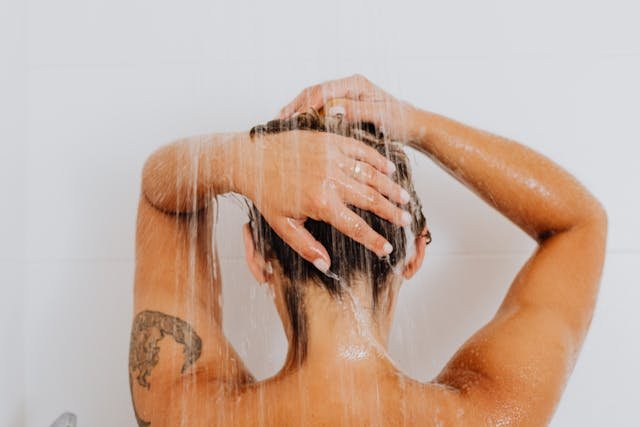
Most women often overlook the ingredients in their shampoo until they experience a problem. What exactly is in that bottle you use several times a week? The typical shampoo contains 10-30 chemical components, many of which can be more harmful than beneficial, especially for women’s hair.
Understanding Hair Fundamentals and the Importance of Ingredients
Women’s hair differs from men’s. Generally, our hair strands are finer, yet we have more of them. Hormones can disrupt our growth cycles, and our scalps produce varying oil levels throughout the month. Due to these differences, harmful ingredients can have a more severe impact on our hair.
Imagine each hair strand covered in small scales, similar to roof shingles. Harsh shampoo components can pry these scales open, revealing the inner core where the hair’s strength and color reside. Repairing the damage becomes difficult once it’s done.
Harmful Sulfates You Should Avoid
Enjoy that rich lather while washing? It’s likely due to Sodium Lauryl Sulfate (SLS) – which can severely damage your hair. SLS doesn’t just cleanse dirt; it strips out every bit of natural oil. On colored hair, it accelerates fading. If you have curls, SLS is detrimental to your curl pattern.
Sodium Laureth Sulfate (SLES) may seem milder but doesn’t differ much. After SLES strips your scalp, it compensates by overproducing oil. Consequently, you may end up washing more often, worsening the situation.
Silicones and Their Concealed Downsides
That quick smoothness from dimethicone-rich products seems fantastic until the reality sets in. Silicones enclose your hair similarly to plastic wrap, masking rather than repairing damage.
The primary issue? Many silicones don’t rinse out effectively. They accumulate, preventing moisture from penetrating the hair shaft. Women with fine hair are particularly affected, as silicones tend to make their hair appear even flatter and limper.
Problematic Preservatives
Parabens have earned their negative reputation. These preservatives (methylparaben, propylparaben, butylparaben) mimic estrogen in the body. Scientists have discovered parabens in breast cancer tissues. Although research is ongoing, why take the risk?
More unsettling are the formaldehyde-releasing preservatives like DMDM hydantoin and quaternium-15, which slowly release formaldehyde (commonly used in mortuaries) to keep the shampoo bacteria-free.
Artificial Fragrances and Color
Does your label say “fragrance”? That single term can conceal a multitude of secret chemicals. Companies aren’t required to disclose the contents of their scent blends. These unidentified ingredients can cause headaches, rashes, and respiratory issues for many women.
The vibrant colors in your shampoo don’t contribute to your hair’s wellbeing. FD&C and D&C dyes merely enhance the bottle’s appearance while potentially irritating your scalp.
Alcohols That Dry and Damage
Not all alcohols are harmful to your hair. The detrimental ones – isopropyl alcohol, SD alcohol, and ethanol – evaporate rapidly, leaving your hair dry. Women with dry or curly hair should avoid these ingredients.
However, cetyl alcohol and stearyl alcohol are beneficial despite the shared name. These plant-based components moisturize and soften the hair. Same term, entirely different outcomes.
Anti-Dandruff Ingredients: Beneficial or Harmful for Women?
Have you observed your dandruff worsening before menstruation? That’s normal. Hormones influence scalp health, making anti-dandruff product selection challenging for women.
Zinc pyrithione is effective when combined with the right complementary ingredients. The optimal effect occurs when paired with botanical extracts that avert dryness.
The Balancing Shampoo achieves this by blending zinc pyrithione with botanical extracts that maintain scalp health. Unlike typical medicinal-smelling dandruff shampoos, it has a pleasant fragrance. Women report it doesn’t fade their color or leave hair feeling dry. This highly-regarded product reduces breakage, soothes the scalp, and keeps hair vibrant without harsh chemicals.
Selenium sulfide eliminates dandruff but can cause an uneven and patchy appearance to your costly dye job.
Ketoconazole functions like prescription-strength medicine, but excessive use destroys beneficial microbes on the scalp alongside harmful ones.
Women experiencing postpartum hair changes or monthly hormonal fluctuations need products that treat and nourish. The Balancing Shampoo does just that – controlling oil without compromising hair health.
Superior Alternatives
Shampoos without sulfates that use milder cleansers like coco glucoside and sodium cocoyl isethionate cleanse effectively without stripping natural oils. Although they don’t lather as much, your hair will appear healthier in only a few weeks.
Proper conditioning ingredients make a significant difference. Shea butter, argan oil, and panthenol (vitamin B5) penetrate the hair rather than merely coating it.
Concerned about product freshness without harsh preservatives? Look for sodium benzoate paired with potassium sorbate. No preservative is flawless, but these have better safety credentials.
Utilizing matching products significantly enhances results. The Balancing Shampoo, when used with its companion, Nourishing Conditioner, provides continual care for your scalp and hair, delivering outcomes that random product pairings can’t achieve.
How to Interpret a Shampoo Label
Ingredient lists are not random. They follow a concentration order, with the most prominent ingredients appearing first. Those initial few components make up the majority of what you’re applying to your head.
Don’t rely on flashy front labels. A bottle advertising “ARGAN OIL MIRACLE!” might contain only a trace of argan amidst many cheap, harmful ingredients. Apps like Think Dirty and EWG’s Skin Deep help decipher marketing claims and reveal the true content.
Better Ingredients, Better Hair – It’s That Simple
Your shampoo should clean your hair without damaging it. That’s not too much to ask.
By avoiding harsh sulfates, silicones, questionable preservatives, artificial fragrances, and drying alcohols, you can break the cycle of damage that many shampoos cause. Your hair can actually repair itself instead of merely appearing temporarily improved.
Many women spend years questioning why their hair doesn’t improve despite trying numerous products. Switching to better formulations, like dandRX anti-dandruff shampoo or those containing zinc pyrithione paired with nourishing botanicals, unveils the true potential of your hair – healthy, strong, and free from flakes, without compromise.
Examine your shampoo label. Your hair deserves better than a mixture of chemicals.





